[ad_1]
Have you ever felt that you rely too much on your intuition and leave out the needs of your customers when making decisions? No worries, there is a great way to introduce your customers’ voices back into your day-to-day—conducting surveys. In this guide, I will help you with this by going over a couple of survey questions for product feedback that you can use.
Yes, Product Feedback Surveys Are Still A Thing
…and the Best Product Teams Use Them Constantly.
Feedback surveys are incredibly popular (with around 7% of the top 1 million sites using Hotjar alone) as they have the ideal balance of giving you statistically significant data that is also carrying lots of qualitative insights and individual feedback.
I agree, we live in the age of big data and advanced tracking that can let you analyze the behavior patterns of your users and even predict their future actions. However, there is one critical element that big data is missing—context.
You might see that users from a given country are highly active on Sundays using big data, but you will never find out the real reason (Sunday is the first day of the week in their culture) until you ask them about it.
Now that you know that surveys are something worth spending time on, let’s see what are some of the best questions that you can add to them.
Benchmark Your Customer Experience (CX)
Every successful product and the business standing behind is built atop a happy customer base. Fall short of your customers’ expectations, and you will end up losing customer loyalty and retention—which will result in you becoming profitable but unsustainable at best, and failing as a business at worst. Therefore, it’s critical to measure your customer experience and improve it.
I have divided the questions that you can ask in your customer satisfaction surveys into three groups, based on the key metric that they are helping you measure.
Note: I will be using Typeform for my examples in this guide, but be sure to check out others in our guide on best user feedback and survey tools.
Measure Customer Satisfaction Score (CSAT)
CSAT is one of the most popular metrics that companies use to monitor the level of satisfaction among their users.
There are many ways that you can measure CSAT, including surveys consisting of multiple questions. But, I can recommend you stick to the most basic method that consists of a single question.
Here, I have picked the classical “5 stars” closed-ended question format for the respondents to use to grade their level of satisfaction, but you can use any other format as well, including:
- Boolean answers: Satisfied/Unsatisfied or 👍/👎.
- Multiple choice answers: Very Satisfied, Satisfied, Somewhat Satisfied, Not Satisfied.
- Opinion Scale: On a scale from 1-7, how satisfied are you? You can also use a Likert Scale for this.
No matter which format you choose, you will need to calculate the percentage of survey responses with a positive score. In the case above, we will consider the responses with 4 and 5 stars as positive and calculate our CSAT with this formula:
The reason I like this simple format of measuring CSAT with a single question is in your freedom to place this survey anywhere you want, including integrating it into your product UI.
Measure Net Promoter Score (NPS)
Your Net Promoter Score represents the sentiment of your customer base towards your product when they talk about you to others.
Although this is important for all companies to measure, it is especially critical for those products that rely on the word-of-mouth (WOM) channel as their main source of growth.
Unlike its predecessor, there is only one true way of measuring NPS which, again, has only one question to answer:
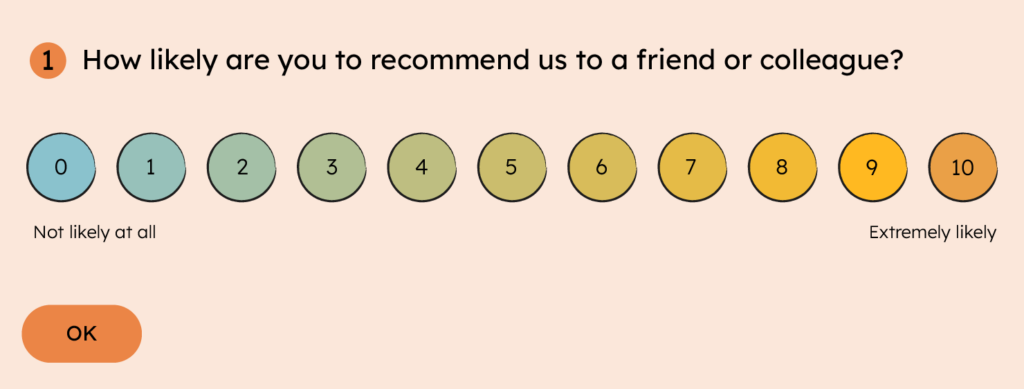
The format of the answer is quite standard as well – a scale from 0 to 10 where:
- People with a score of up to 6 are your detractor users.
- Those with a score of 7 and 8 are your passive users.
- And whoever has given you a score of 9 or 10 is your promoter user.
You calculate the metric itself with this formula:
As we can see from the formula above, passive users do not really have any impact and it is mostly about having more promoters than detractors. A healthy NPS score is anything above 0%. If you go beyond 50%, then you are doing a great job at customer satisfaction and WOM. A score of >75% is considered world-class.
Measure Customer Effort Score (CES)
Your CES score will tell you if your customers are able to use your product with ease to cover their needs.
While CSAT was an overall sentiment score and NPS shows the “quality” of word-of-mouth that you are getting, CES represents the state of your user experience. A low CES score means that your users are unable to navigate through your app and use your features to fulfill their needs successfully.
Customer effort score is another single-question survey. In this case, the question is:
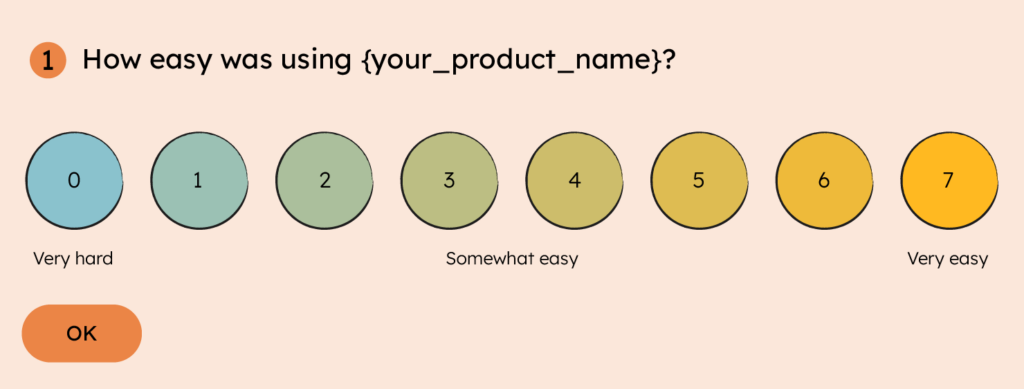
The format of a scale from 0 to 7 is arbitrary, you can choose any scale (including 5 stars) to measure this customer experience metric.
Regarding calculation, the customer effort score is the average of all responses you have received. Its formula is:
The highest value that you can earn is the top score of your scale (which is 7 in the example above) and the lowest value is 0. Unlike NPS, there is no benchmark for a CES score, and your aim is to continuously work on improving your UX and strive for the highest score.
Although there are many other types of metrics along with their corresponding questions that you can use to measure your customer experience, these three were the main and most important ones to keep an eye on.
With the topic of customer experience clear, let’s move to other areas of product feedback and discuss some of the questions that you can ask your users for gaining useful customer insights in those areas.
Discover Your Use Cases
Surveys are a very popular and integral part of the new product discovery process along with user interviews and qualitative data analysis.
The benefit of using questionnaires in product research is that they contain more qualitative insights than data analysis and more quantitative/measurable information than user interviews at the same time. Essentially, they have a balance between the amount of data and its insightfulness.
In terms of the survey frameworks that you can use for your product discovery, let’s talk about Jobs To Be Done and problem discovery.
Uncover Your Users’ Jobs To Be Done
The Jobs To Be Done (JTBD) framework is helping product teams uncover the needs of their target customers by discovering and defining the “jobs” that these users need to do and they are ready to “hire” your product to handle that job for them.
Note: JTBD is a great framework overall that helps you set the right priorities for your products and I recommend you read the book about it.
My favorite way of running a JTBD research is by uncovering the jobs with discovery interviews and validating them with a bit more data using JTBD surveys. Here’s what you can expect to see in such a survey.
JTBD Question #1

The key value you are getting from this open-ended question is the administrative context of your users. No matter what kind of task (or job) they are performing, the chances are high that there is a need for some form of planning and decision-making before they move on to the task itself.
For instance, imagine that you are a credit officer at a bank and you have a job-to-be-done of “getting a high-quality evaluation of a credit application from a customer so that you decrease the risk of them not paying for the credit.”
In order to do your evaluation, you will first need to gather data about the customer from credit scoring agencies and your internal database. Moreover, imagine that you need the approval of your manager to request a background check on the customer, too.
If there is a startup that wants to automate this evaluation process for you and ask you to “hire” their product to handle your job-to-be-done, they would definitely need to know that there is a need to get data from a scoring agency and it should have the functionality of allowing your manager to approve your requests.
JTBD Question #2
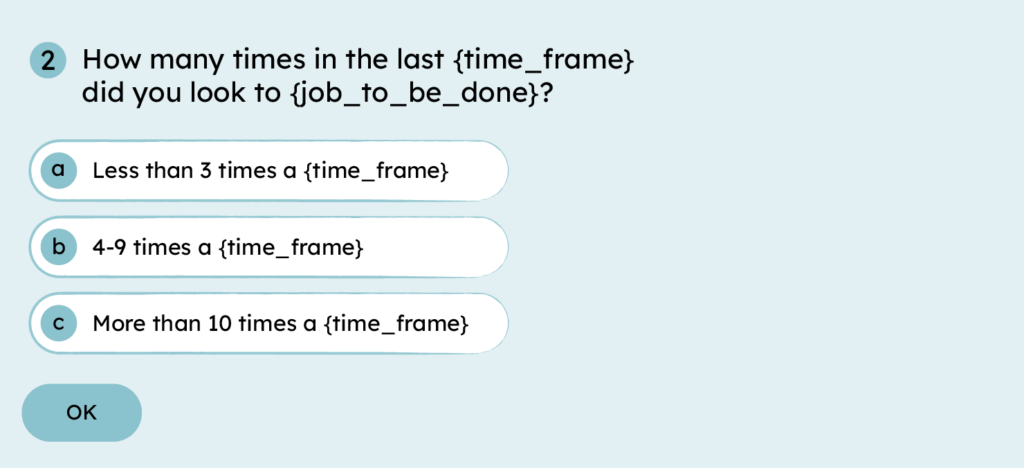
Here, your goal is to discover the natural frequency of the job that you want to handle for them. If you know the frequency of the job, it will serve you as a benchmark for measuring the stickiness and engagement of your product.
If you are in charge of Zoom with a JTBD of “Helping Remote Teams Connect”, then the respondents of your JTBD survey will tell that they connect with their remote team every day (at least 5 times per week). It means that the natural frequency of your JTBD is daily, and if your analytics is showing that your users are making calls only 2 days a week, then your product is not sticky.
JTBD Question #3

This question has the potential to become a treasure trove of feature ideas for you. By asking your target audience this question, you are able to discover their underserved needs and pains that you can address with your product’s features.
Moreover, if they are using an alternative solution to cover their job and still experience these challenges, it means that covering them will give you a competitive edge over these alternatives.
JTBD Question #4

This particular question can uncover the monetary value that your customers will get if you handle that particular job for them. Not only you can use this information in your marketing campaigns (e.g. subscribe to our product and get 200% ROI) but you can also use it as a benchmark for setting your product price.
This is known as Value-based pricing or Premium pricing, you can check it out along with others in our pricing strategies guide.
There are lots of other product survey questions that product teams use for JTBD, but I’d recommend you keep the survey short and limit yourself to the four most valuable questions I have here.
JTBD is a great framework for uncovering and defining your customer needs, but you can accomplish that goal without a dedicated framework too by conducting ordinary problem discovery research.
Discover Your Users’ Problems
As you would expect, problem discovery research does not have a specific structure or rules like the JTBD framework. Therefore, each product team chooses its own way of conducting this research and picking the right questions that they want to ask in their surveys.
Here are a couple of questions that product managers like to use in their problem-discovery research.
Problem Discovery Question #1

With this question, you are able to discover the key motivations behind your users’ decision to pick your product. This is a high-level question that can touch upon many aspects of your product (maybe it was your low prices or a feature that you have added recently).
Sometimes you plan on solving problem A for your user base, then you find out that it was not really a problem for them and they are instead using your product to solve their problem B.
For instance, Flickr started as a game called “Game Neverending.” While the game itself failed, its photo-sharing feature became so popular that the company decided to pivot and focus on it instead.
This situation is quite common and you can uncover the hidden problems of your users with the question above.
Problem Discovery Question #2

You can ask this question both for the features you have in your product and the features that you plan on adding in the future.
For existing features, this question serves a goal similar to the previous one we discussed as you are trying to find the problem it covers and the cohort of users that the feature clicks with.
If you have not built the feature yet, this question will help you gather valuable insights and context about the use case of that feature. You will then use this feedback to shape your feature in a way that covers that use case the best.
Problem Discovery Question #3

This question addresses the area that we might call “badly-solved problems.”
If your users have bought your product, then you have been a “good enough” solution to their problem. But the chances are high that you have still done something ungraceful in your attempts at solving the problem. While the cohort that answered this question did not churn from it, you have most probably lost other potential clients because your shortcoming was significant to them.
With this question, you can discover these shortcomings and fix them.
To sum up, discovering the use cases of your product as well as the jobs that it covers is a critical part of product development. But don’t forget that you are not alone in the market, and it is worth looking at what others are doing too.
Analyze Your Competition
No matter which type of product you create, almost certainly there will be at least one other team somewhere else in the world that will either directly or indirectly compete with you. Most probably they will be in different phases of their product lifecycles and you will have both pre-seed and well-established competitors to face in the market.
In order to comfortably compete with these products, you will need to create so-called “competitive advantages,” which are aspects of your product that are better than others in the market. Competitive advantages can be anything, starting from prices and certain important features and ending with the types of customer support that you provide.
But before you create these advantages, you will first need to see where your competitors excel and what their weaknesses are. Among the many ways of conducting competitive market research, surveys are one of the most popular. They involve reaching out and surveying your competitors’ old and new customers in order to get hands-on feedback about the pros and cons of these products.
If you want to conduct a competitor survey too, here’s what you can include in it.
Competitor Research Question #1
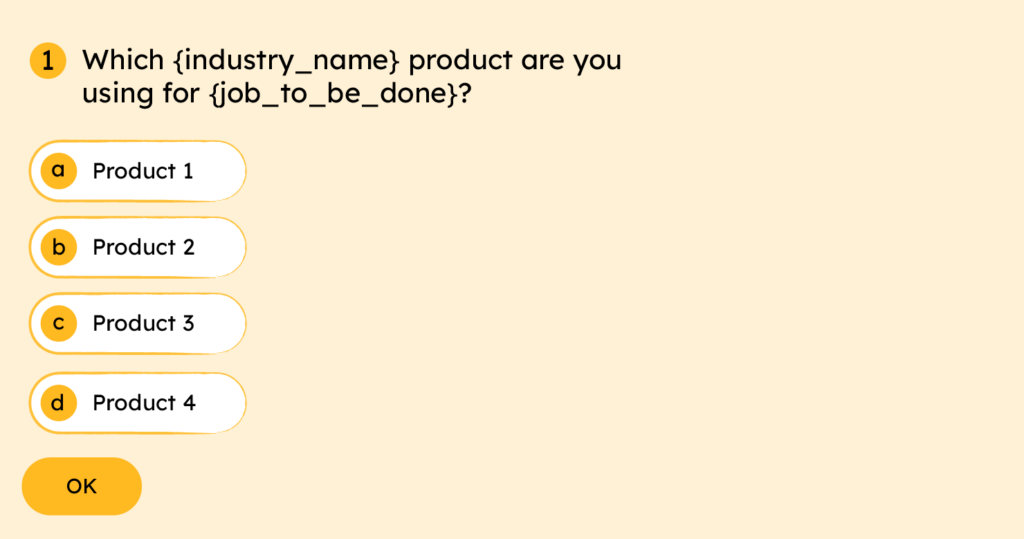
This is the starting multiple-choice question in your survey that, apart from identifying the product name that they will be talking about in your survey, will also help you get a statistical overview of the market shares and the popularity of products they use.
Competitor Research Question #2

You can call this question a “test for positioning.” Although you can reveal the positioning of your competitor from their website and marketing content, it will not necessarily match with that in the minds of their customers.
For instance, I remember analyzing a competitor in the web push notifications market that had very clear and loud messaging on their website about them being the push notification tool specialized for bloggers and publishers. However, after talking to some of their customers, I soon found out that the reason websites used that product was not the publisher-specialized features, but the fact that it was able to work with iOS devices (back then iOS would not allow web push and they had found a workaround).
Competitor Research Question #3

Here we have an opportunity to identify the gaps in the market. Maybe there is a certain feature that none of your competitors have covered, or there are some grumblings around the pricing model that the customers don’t like in the industry (e.g. everyone charges flat monthly fees while users prefer usage-based charging).
My recommendation here would be to include some form of a follow-up question about their persona (e.g. your industry, position, etc.) in your survey template in order to group these gaps based on different cohorts. Usually, each cohort will have underserved needs that are very specific to their industry and will not be that valuable to others.
Competitor Research Question #4

With this question, you will discover the strong sides of your competitors. You will then use this information as a base to plan your backlog of improvements (if you want to build something similar to play on a level field) and competitive strategy (if you want to leapfrog off of this advantage into a better advantage for yourself).
Competitor Research Question #5

While the previous question was meant to uncover the strengths of your competitors, this one is about their weaknesses. Again, the information you gather here will affect both your product roadmap (fix the problem they have in your product) and competitive strategy (be loud about their weaknesses in your marketing communication).
In summary, you can significantly improve your product and your position in the market with well-executed competitor research. But learning about your users’ JTBDs and competitors’ pros/cons is not all that you can do with surveys. Let’s look at a couple of extra questions that are worth asking your users, too.
Bonus: Customer Feedback Survey Questions for Measuring Product-Market Fit and Defining Your Target Demographics
Did I hear you say “encore?” Let’s talk about two other areas where you can use surveys and showcase their questions.
Firstly, let’s talk about product-market fit. PMF is the phase in your product lifecycle when the market has accepted your value proposition, you have a steadily-growing customer base who are ready to pay for your product.
There are many methodologies for detecting a PMF for your product and one of them, called the Sean Ellis Test, uses a survey with a single question:
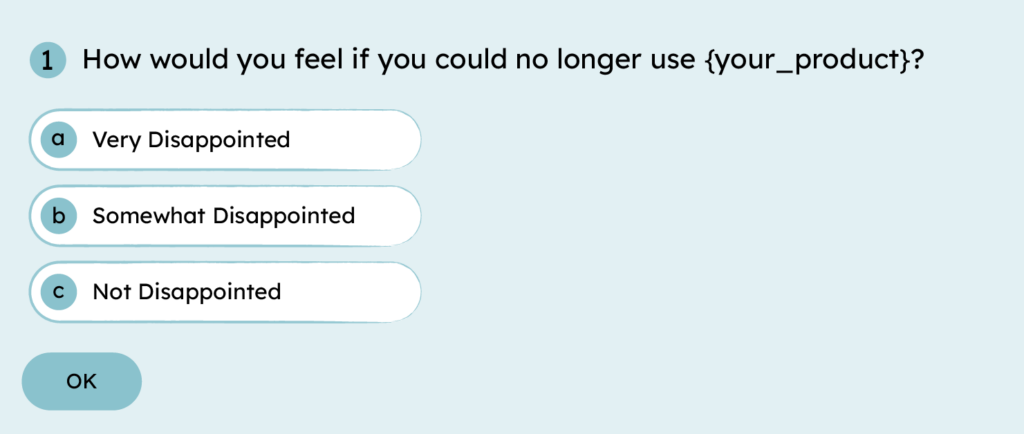
After gathering the results from this survey, you will then look at the number of respondents who would be very disappointed if your product was gone. You want that number to be above 40% as it would indicate that you have successfully reached your PMF.
Now let’s talk a bit about your demographics and target persona. Honestly, I do not believe in demographics (e.g. age and sex) that much and prefer building cohorts based on user needs, industry, interests, etc.
For productivity tools, for instance, I love asking these two questions:
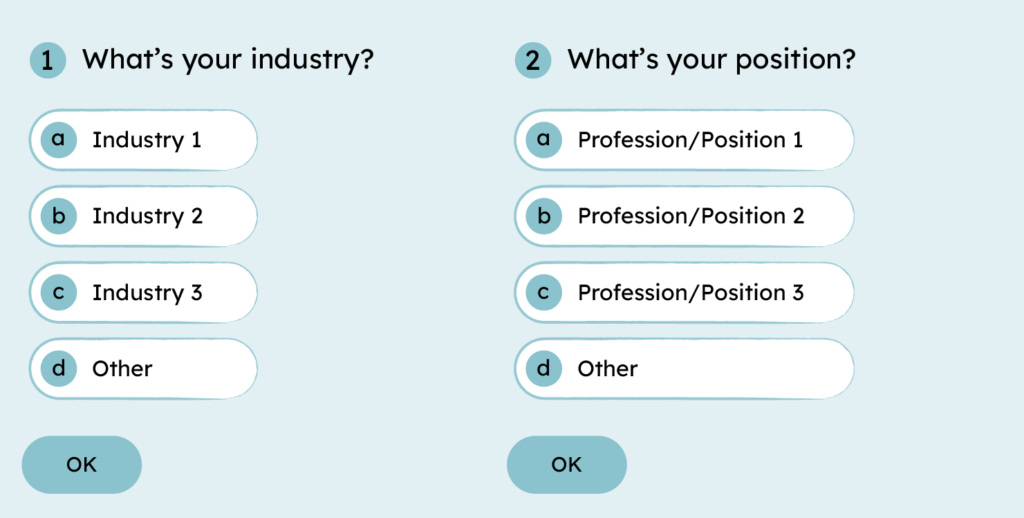
With these types of questions, you are not only able to determine the niche that most of your users come from, but you will also understand the profession and the position of your target user and shape your new features and product experience around them.
Now Back To You!
Product surveys are an incredibly valuable tool in the hands of product teams to make impactful decisions based on the valuable insights that they have gathered from their potential customers.
Please feel free to steal the questions I have here and add them to your next survey. Good luck making valuable discoveries with it and getting to know your users better!
If you liked this guide, make sure to check out some other valuable pieces that we have on product management, such as:
Finally, make sure to subscribe to our newsletter, and let us deliver valuable knowledge about product management to your inbox!
[ad_2]
Source link









